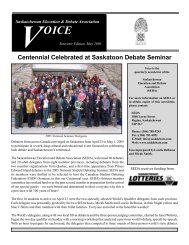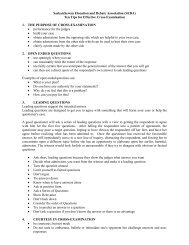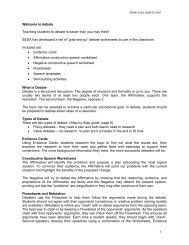Human Cloning - Saskatchewan Elocution and Debate Association
Human Cloning - Saskatchewan Elocution and Debate Association
Human Cloning - Saskatchewan Elocution and Debate Association
You also want an ePaper? Increase the reach of your titles
YUMPU automatically turns print PDFs into web optimized ePapers that Google loves.
Brave New World Page 2 of 5<br />
Smithsonian, December 2001<br />
that are prevalent in families or<br />
in certain ethnic groups —<br />
starting with such single-gene<br />
disorders as cystic fibrosis, Tay-<br />
Sachs disease <strong>and</strong> sickle-cell<br />
anemia — because medical<br />
histories of affected families<br />
were available <strong>and</strong> the fruits of<br />
such research might save, or at<br />
least improve, countless lives.<br />
As our underst<strong>and</strong>ing of our<br />
genes has increased, so have our<br />
choices dealing with birth <strong>and</strong><br />
conception. For several decades,<br />
couples with family histories of<br />
particular diseases have sought<br />
the advice of genetic counselors<br />
about whether to have children.<br />
With amniocentesis — a<br />
procedure in which amniotic<br />
fluid is extracted from the<br />
womb <strong>and</strong> examined —<br />
expectant mothers have long<br />
been able to determine if a<br />
developing fetus has certain<br />
chromosomal disorders. But<br />
more recent advances have<br />
brought the potential for couples<br />
to be advised not only on the<br />
basis of family history but on<br />
the presence of genetic markers<br />
of hereditary disease in their<br />
DNA. And with IVF technology<br />
came the ability to screen<br />
embryos for chromosomal<br />
anomalies — <strong>and</strong> for specific<br />
genetic traits, including genetic<br />
diseases.<br />
Along with advances in<br />
screening in recent decades,<br />
there has been a surge of<br />
research on ways to treat<br />
existing genetic disorders. That<br />
research was based largely on<br />
two great truths that had been<br />
revealed about DNA. The first<br />
is that the sole function of most<br />
genes is to give cells encoded<br />
instructions for churning out<br />
particular proteins, the building<br />
blocks of life. There are tens of<br />
thous<strong>and</strong>s of different proteins<br />
in the human body — from<br />
collagen <strong>and</strong> hemoglobin to<br />
various hormones <strong>and</strong> enzymes<br />
— <strong>and</strong> each is encoded by a<br />
particular order of nucleotides<br />
in a gene. (Many diseases are<br />
caused by defective genes that<br />
don't produce their protein<br />
correctly — <strong>and</strong> treatments that<br />
introduce missing proteins have<br />
long been used for such<br />
disorders as diabetes <strong>and</strong><br />
hemophilia.)<br />
The second insight is that all<br />
living things use the same basic<br />
genetic code. Just as all the<br />
books in a great library can be<br />
written in a single language, so,<br />
too, are all living things the<br />
result of different messages<br />
"written" in the same exact<br />
DNA language — <strong>and</strong> "read" by<br />
our cells. This means that if a<br />
stretch of DNA is taken from a<br />
donor <strong>and</strong> inserted into the<br />
DNA of a host's cells, those<br />
cells will read the new message,<br />
regardless of its source.<br />
Though there are endless<br />
possible applications for this<br />
phenomenon (<strong>and</strong> at least as<br />
many complicating factors),<br />
doctors found particularly<br />
promising the idea of fixing<br />
broken genes by manipulating<br />
DNA through a process known<br />
as gene therapy, a form of<br />
genetic engineering.<br />
GENE THERAPY<br />
In some ways, manipulating dna<br />
is a completely natural<br />
phenomenon. Certain kinds of<br />
viruses — including HIV <strong>and</strong><br />
others — infect us by inserting<br />
their genetic information into<br />
our cells, which then haplessly<br />
reproduce the invading virus. In<br />
some forms of gene therapy,<br />
this kind of virus itself is<br />
engineered so that the viral gene<br />
that causes the disease <strong>and</strong><br />
allows the virus to reproduce is<br />
removed <strong>and</strong> replaced with a<br />
healthy version of the human<br />
gene that needs "fixing." Then<br />
this therapeutic, engineered<br />
virus is sent off to do its work<br />
on the patient's cells. There are<br />
hundreds of procedures using<br />
such "viral vectors" in clinical<br />
trials today, targeting diseases<br />
that range from rheumatoid<br />
arthritis to cancer. So far there<br />
have been few, if any, real<br />
successes — <strong>and</strong> the field<br />
received a serious setback in<br />
1999 when a patient died while<br />
undergoing gene therapy trials<br />
for liver disease.<br />
But even if this form of gene<br />
therapy, or one like it, can be<br />
made to be safe <strong>and</strong> effective, it<br />
still represents a relatively<br />
short-term approach to genetic<br />
disease — compared with what<br />
is theoretically possible. After<br />
all, even if individuals can be<br />
successfully treated, their<br />
descendants would likely still<br />
inherit the gene or genes that<br />
caused their ailments. The form<br />
of gene therapy we've been<br />
discussing affects so-called<br />
somatic cells, which make up<br />
the vast majority of cells in our<br />
body. But it is not somatic cells<br />
but germ cells — our eggs <strong>and</strong><br />
sperm — that pass our genes to<br />
our offspring.<br />
GENETIC ENGINEERING<br />
When talking about changing<br />
the DNA in human germ cells,<br />
scientists use the term "germ<br />
line therapy." But in plants or<br />
animals, it's what we commonly<br />
think of as "genetic<br />
engineering." Either way, it<br />
means altering the DNA of an<br />
organism in a way that increases<br />
the likelihood (or, in some<br />
cases, ensures) that all of its





